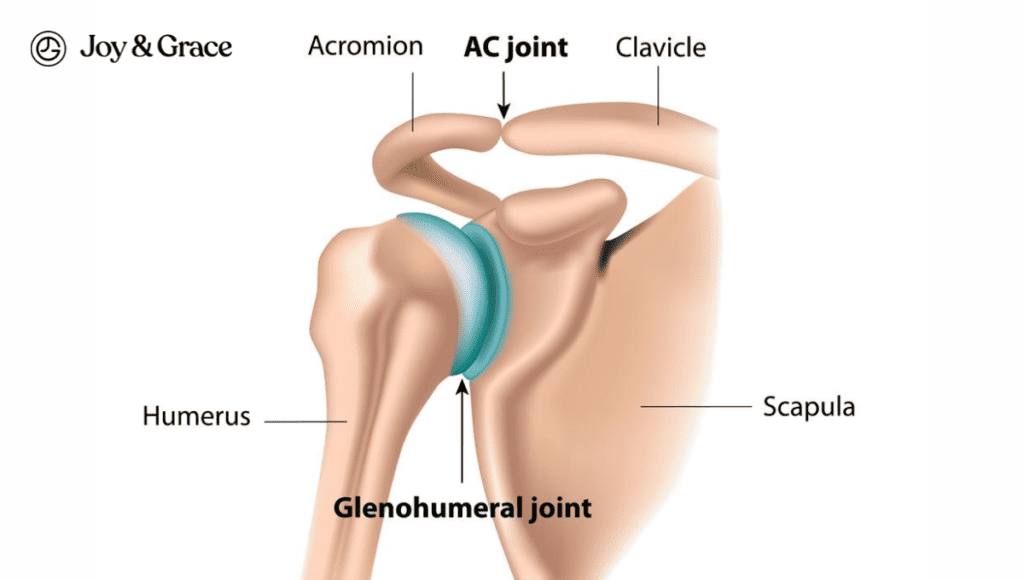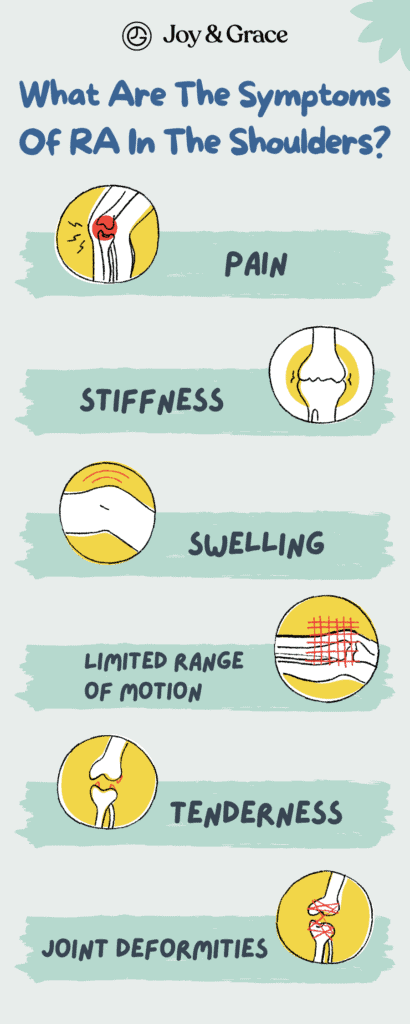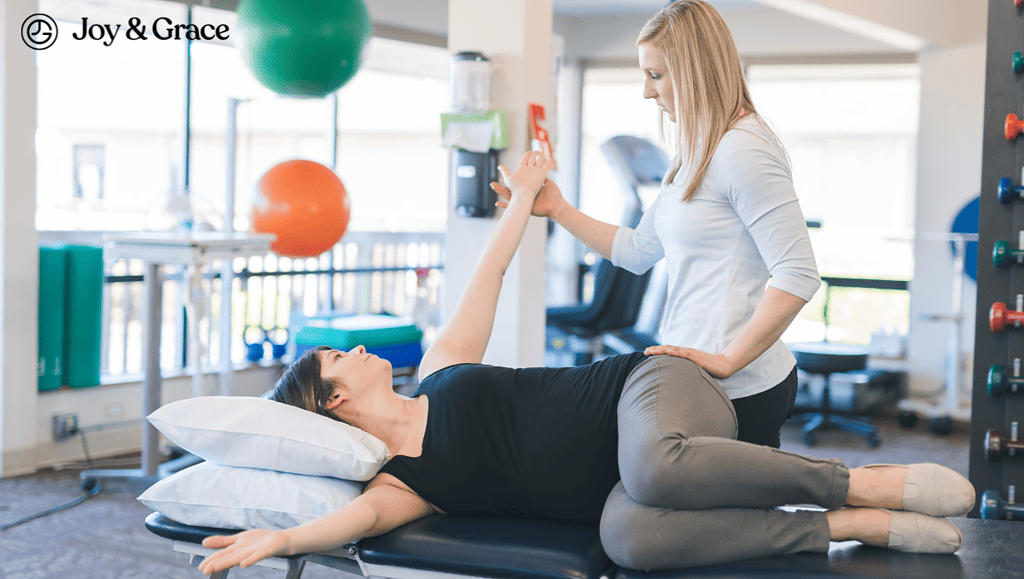Imagine waking up to a stiff and painful shoulder. Surprisingly, many people with rheumatoid arthritis experience this kind of pain every day.
One possible symptom of this chronic inflammatory disease is shoulder pain. The pain can be incredibly bothersome, especially at night. This pain can hold you back from living your life to the fullest.
In this blog, we will explore why rheumatoid arthritis leads to shoulder pain. We'll discuss how it affects your life and, most importantly, share tips to help you ease the suffering.
Can Rheumatoid Arthritis Cause Shoulder Pain?
Yes, rheumatoid arthritis (RA) can indeed lead to shoulder pain, although it typically does so in the later stages of the disease.
Shoulder pain is apparently common with rheumatoid arthritis.
However, it’s important to note that the occurrence of shoulder pain among patients with rheumatoid arthritis has decreased over the years. This is possibly due to the use of newer drugs called biological agents.
In a study from 1986, 96% of the 105 patients had shoulder problems.
Only in 1998 did the FDA approve the first biologic agent for use in rheumatoid arthritis.
Subsequently, in a study from 2015, 53.4% of the 103 patients who took part had shoulder pain and had trouble using their shoulders.
While these two studies don't conclusively show a 50% reduction in shoulder issues, they do indicate a notable trend, suggesting that biologic agents may be effective in slowing the progression of the disease.
This also highlights the importance of proper treatment in preventing shoulder involvement and damage.
Rheumatoid arthritis (RA) is a chronic autoimmune disorder that primarily affects the joints. It's characterized by inflammation, pain, and joint damage.
In contrast to osteoarthritis, which results from wear and tear, RA triggers an immune system attack on the synovium. The synovium is the lining of the membranes that surround the joints.
RA can affect joints throughout the body, both small and large. However, it tends to primarily target the smaller joints. Aside from the shoulder, commonly affected joints include:
- Hands and Wrists
- Feet
- Knees
- Elbows
- Ankles
- Hips
According to a study from 1994, shoulders are usually only affected late in the disease when all other joints have been damaged. We’ll talk more about that later.
Can Rheumatoid Arthritis Start In The Shoulder?
Rheumatoid arthritis rarely starts in the shoulders. The most common joints that rheumatoid arthritis first affects are:
- The fingers,
- Wrists, and
- Toes.
As mentioned, shoulder involvement is usually seen only in long-term rheumatoid arthritis.
For example, in a study from 2021, only two patients out of 113 had shoulder monoarthritis from RA upon diagnosis. Monoarthritis means only a single joint is affected (in this case, the shoulder). Interestingly enough, both patients were over the age of 60.
According to a journal article, shoulder symptoms from RA usually appear early in patients over 60 years old.
In another study of 102 people, only 9% said their shoulder was the first joint to be affected by Rheumatoid arthritis.
Rheumatoid arthritis can also affect a joint near your shoulder—your neck. Below, we'll briefly discuss rheumatoid-related neck pain. If you're interested in reading in more detail, however, we also have a separate article.
Can RA Affect The Neck Or Shoulder?

As we've already discussed, RA can affect your shoulders. But RA does not spare any of your joints, and it can affect your neck as well.
In fact, it’s the third most commonly involved joint in rheumatoid arthritis. Up to 86% of RA patients will have neck involvement, and up to 88% will complain of neck pain.
The neck, or cervical spine, consists of several important joints. It’s made up of seven vertebrae (C1–C7) and their connecting joints. According to a study, the atlantoaxial joint, made up of the C1 (atlas) and C2 (axis) vertebrae, is most at risk. Damage to this joint can lead to nerve compression and neck instability.
The disease doesn’t always affect the neck, but when it does, it’s usually in the early stages. This is unlike the shoulder, which becomes affected later in the disease.
What Part Of The Shoulder Does RA Affect?

RA can impact any part of the shoulder joint, including the following:
- The glenohumeral joint: This is where the top of your upper arm bone (the ball) fits into a socket in your shoulder blade.
- The acromioclavicular joint: This is where your collar bone meets the front part of the shoulder blade.
Since the disease can affect all parts of the joint, you may feel the pain all over your shoulder.
How Does Rheumatoid Arthritis (RA) Affect My Shoulders?
RA is characterized by synovitis, or inflammation of the lining of your joints. As the synovium becomes inflamed, it can produce excess fluid in your joint. The excess synovial fluid contributes to swelling and discomfort.
Over time, synovitis causes the lining of the joint to thicken and form what’s called a pannus, an abnormal tissue growth. The pannus can invade and damage nearby tissues, including cartilage and bone.
This invasion can lead to joint damage and destruction. In the shoulders, this can result in the erosion of the cartilage that covers the ends of the clavicle and arm bones. Cartilage serves as a cushion and allows your joints to move smoothly. As the loss of cartilage progresses, bones can rub against each other ("bone on bone"), causing pain, reduced range of motion, and deformities.
Rheumatoid arthritis can additionally cause painful movement restrictions similar to capsulitis and lead to a "frozen shoulder." This usually causes pain at night when the person sleeps on the affected shoulder.
This process can also make you more susceptible to developing rotator cuff tears, a common cause of severe shoulder pain.
What Are The Symptoms Of RA In The Shoulders?

Since rheumatoid arthritis (RA) is an inflammatory disease, its main shoulder symptoms are usually pain and limited movement:
- Pain
Persistent pain is a hallmark of RA. The pain might be more pronounced during movement or at rest, depending on the stage and severity of the condition.
- Stiffness
RA often leads to joint stiffness, particularly in the morning or after periods of inactivity. You may also hear a grinding or popping sound.
- Swelling
Inflammation caused by RA can lead to joint swelling. Swollen shoulder joints might feel warm and appear redder and larger than usual.
- Limited Range of Motion
As RA progresses, it can cause joint damage and deformities. This can result in a loss of motion in the shoulders. This makes it difficult to raise the arms or perform other shoulder movements.
- Tenderness
The affected shoulder joint might be tender to the touch, particularly during the more active stages of the disease.
- Joint Deformities
In advanced stages of RA, joint damage can lead to deformities. This can affect the shape and structure of the shoulder joint, resulting in functional limitations.
However, these symptoms can also be seen in many other conditions. Having these symptoms doesn’t necessarily mean you have rheumatoid arthritis. In just a moment, we will talk about how doctors figure out if you have rheumatoid arthritis.
What Are Early Signs My Shoulder Pain May Be RA?
Early signs that your shoulder pain may be caused by Rheumatoid Arthritis (RA) involve more than just a simple aching sensation. If you're concerned that your shoulder pain may be related to RA, here are some early signs to watch out for:
- Accompanying symptoms
Patients with rheumatoid arthritis usually have other symptoms related to inflammation. These can include:- Unintentional weight loss
- Feeling weak
- Tiredness
- Muscle pains
- Issues with smaller joints
You will usually also have pain, stiffness, and swelling in the joints of your hands and feet. These may be present long before your shoulder pain appears.
What Does Rheumatoid Arthritis Shoulder Pain Feel Like?

So you might be wondering, what does RA shoulder pain feel like? Well, the pain can feel like a constant dull ache in your shoulder that worsens into a sharp, severe pain when moving. Imagine a feeling similar to a toothache but located in your shoulder. The pain can throb continuously and worsen when you try to lift something or move your arm.
Shoulder pain from rheumatoid arthritis is not restricted to waking hours and can be relentless at night. This can prevent you from getting a good night’s sleep and exhaust you all day.
It's also not uncommon for RA symptoms to fluctuate. There can be periods of intense pain, known as “flares,” and times when you won’t have any symptoms, called “remission.”
However, this may only apply to some, as the disease can affect people differently. One thing we know for sure is that this isn't a 'grin-and-bear-it' type of pain.
Does Rheumatoid Arthritis Cause Pain In Both Shoulders?
RA often affects joints symmetrically, meaning that if one shoulder is affected, the other may be as well.
However, the severity and pattern of joint involvement can vary from person to person. Some individuals with RA might experience pain and inflammation in just one shoulder.
For instance, in one study, 32% of patients had symptoms in only one shoulder, while 21.4% had symptoms in both shoulders.
Can Rheumatoid Arthritis Cause Shoulder Blade Pain?
Yes, rheumatoid arthritis can cause shoulder blade pain. If you can recall, the parts of the shoulder affected by rheumatoid arthritis all connect to the shoulder blade. Hence, the inflammation in these joints can also lead to pain in your shoulder blades.
How Do I Know If I Have Rheumatoid Arthritis In My Neck And Shoulder?

Having the symptoms mentioned above is not enough to diagnose rheumatoid arthritis in the neck and shoulder. As we said earlier, these symptoms also occur in other conditions. To make things more complicated, other kinds of arthritis share the same symptoms.
Consulting with a healthcare professional is the only surefire way to know if your symptoms are due to rheumatoid arthritis (RA). If you're worried your shoulder and neck pain is from RA, consider making an appointment with a rheumatologist. They specialize in diagnosing and treating conditions like rheumatoid arthritis.
How Do Doctors Diagnose Shoulder RA?
Diagnosing rheumatoid arthritis (RA), specifically in the shoulder is similar to the general diagnosis of RA. Here's how doctors typically approach diagnosing RA in the shoulder:
Medical History and Physical Exam

The doctor will ask about your symptoms and any history of joint problems or autoimmune diseases. During the physical examination, they will look for signs of inflammation and limited range of motion.
Laboratory Tests
Blood tests are crucial in diagnosing RA in the shoulder, just as they are in other joints. The following tests might be ordered:
- Anti-Cyclic Citrullinated Peptide (anti-CCP) Antibodies
This test is the most specific for RA and can help confirm the diagnosis.
- Rheumatoid Factor (RF)
This blood test checks for the presence of RF antibodies. It's important to note that a positive RF result is not exclusive to RA.
- Inflammatory Markers
Tests such as Erythrocyte Sedimentation Rate (ESR) and C-reactive protein (CRP) can indicate the presence of inflammation in the body.
Imaging Tests
Imaging is crucial in assessing joint damage and inflammation. For diagnosing RA in the shoulder, the following imaging techniques might be used:
- X-rays
- Ultrasound
- Magnetic Resonance Imaging (MRI)
These studies can also be used to track if the disease is getting worse.
Clinical Criteria
The established clinical criteria for RA can guide the diagnosis. In general, the criteria for rheumatoid arthritis are:
- Inflammation in two or more large joints. This includes:
- The shoulder,
- Knees,
- Hips,
- Elbows,
- Ankles
- Inflammation in the small joints
- Presence of biomarkers like rheumatoid factor (RF) or anti-citrullinated protein antibodies (CCP antibodies).
- Elevated C-reactive protein (CRP) levels or an increased sedimentation rate.
- Persistence of symptoms for a duration exceeding six weeks.
The criteria are scored, and a total score is calculated. If your total score reaches a certain threshold, you’re diagnosed with rheumatoid arthritis.
It’s important to note that not all patients with RA will fit this criteria. A diagnosis will still need the judgment of a physician based on your medical history and lab tests.
To effectively manage and relieve RA shoulder pain, an early and accurate diagnosis is essential. Once diagnosed, you can explore various treatment options for managing the disease.
How Do I Relieve Shoulder Pain From Rheumatoid Arthritis?
Here are some simple ways you can manage and reduce RA shoulder pain:
- Physical activity
Regular exercise can help strengthen the muscles around your shoulder joint. It can also improve your flexibility and mobility. Low-impact exercises such as swimming, pilates, and yoga can be beneficial. However, always start a new routine slowly. You can also consult with a physical therapist.
- Regular rest and proper sleep
It's crucial to balance activity with rest. Some individuals with RA also report experiencing rheumatoid arthritis shoulder pain at night. Implementing a regular sleep schedule and optimizing your sleep environment can improve your sleep quality.
- Heat and cold therapy
Applying heat can help relax tense muscles and promote circulation, which aids in reducing stiffness. Cold packs can relieve RA shoulder joint pain by numbing the area to dull the pain.
- Healthy diet
Those with RA may benefit from an anti-inflammatory diet like the Mediterranean diet. This diet contains foods that are thought to help fight inflammation, such as:- Fresh fruits
- Vegetables
- Lean proteins
- Whole grains and nuts
- Healthy fats such as omega-3 fatty acids
- Mind-body techniques
Skills such as mindfulness, breathing exercises, and even some forms of yoga can help manage RA shoulder pain. They help reduce stress and enable better pain management.
Remember, everyone's experience with RA and shoulder pain is unique. What works for others may not be as effective for you. Combine and try different strategies to find what provides you the best relief.
While these may help relieve shoulder pain from RA, they only address the symptom, not the condition itself. You will still need medical treatment to stop the disease from worsening and hopefully get you into remission.
How Do I Sleep With Rheumatoid Arthritis In My Shoulders?
Sleeping with rheumatoid arthritis (RA) in your shoulders can be quite a challenge. Experiencing shoulder pain at night can affect the quality of your much-needed rest. But worry not! Here are some strategies that may provide a more restful night's sleep:
- Body positioning
Your sleeping position can significantly influence RA shoulder pain. Sleeping on your back reduces pressure on your shoulders, which can help minimize pain. If this isn’t comfortable, you may want to try sleeping on the side that doesn't have shoulder pain.
- A supportive mattress
A suitable mattress is essential. A mattress that offers an appropriate balance between comfort and support can aid in reducing the load on your shoulder joints.
- Get the right pillows
Utilizing different types of pillows can provide additional support. Orthopedic pillows, for instance, are designed to help align the spine, which can help reduce pressure on your shoulders. A wedge pillow can also provide added support and positioning to minimize shoulder stress.
- Create the right environment
Creating the right sleep environment can also play a critical role. A quiet, dark, and cool space can significantly improve sleep quality.
Living with rheumatoid arthritis shoulder pain doesn't mean surrendering your beauty rest. Finding what works best for you may require adjustments and patience, but remember, your comfort and well-being are worth the effort.
How Do Doctors Treat Rheumatoid Arthritis In The Shoulder?
Treating rheumatoid arthritis (RA) in the shoulder involves a combination of strategies. These strategies aim to:
- Reduce pain and inflammation
- Prevent further joint damage and loss of joint function
- Improved quality of life
The specific treatment plan can vary based on the severity of the condition and individual factors. Although, when treating RA in the shoulder, nonsurgical treatments are typically tried first. Here are some common approaches to treating RA in the shoulder:
Medications
- Nonsteroidal Anti-Inflammatory Drugs (NSAIDs)
These drugs can help reduce pain and inflammation in the shoulder joint.
- Disease-Modifying Antirheumatic Drugs (DMARDs)
These drugs, such as methotrexate, are used to slow the progression of RA and prevent joint damage.
- Biologic DMARDs
Biologic medications target specific molecules involved in the immune response. They can be effective treatment options for reducing inflammation and halting joint damage.
- Corticosteroid Injections or Pills
Steroid injections or pills can provide rapid relief from pain and inflammation. However, they’re usually used for short-term management due to potential side effects.
Physical Therapy
Physical therapists can design exercises and stretches to improve the shoulder joint's range of motion and strength. They can also provide strategies to manage pain and prevent further stiffness.
Occupational Therapy
Occupational therapists can help you adapt your daily activities. They can guide you on minimizing strain on your shoulder joints and improving your ability to perform tasks with less pain.
Shoulder Surgery
Surgical treatment might be considered in cases of severe joint damage. Shoulder replacement surgery can be an option to improve joint function and reduce pain.
Working closely with a rheumatologist or healthcare team experienced in treating RA is important. Regular monitoring, adjusting medications, and modifying the treatment plan as needed are all part of managing RA effectively.
Can Physical Therapy Help With Shoulder Pain From RA?

Absolutely! Physical therapy is a valuable tool for managing shoulder pain caused by rheumatoid arthritis. Physical therapy for individuals with shoulder involvement from RA can offer several benefits:
- Pain Management
Physical therapists can use various techniques to help manage pain. These can include manual therapy and heat or cold therapy.
- Range of Motion Improvement
Physical therapists can design routines to improve the flexibility and mobility of the joint.
- Strength Training
Muscle weakness often accompanies joint involvement in RA. Physical therapists can develop tailored strength training programs to help improve shoulder strength. This can help stabilize the joint and provide better support.
- Posture and Body Mechanics
Physical therapists can educate you on proper posture and body mechanics to minimize stress on the affected shoulder. This can help prevent further joint damage and pain.
It's important to seek the guidance of an experienced physical therapist with an understanding of RA. The therapist will collaborate with your physician to ensure the therapy program is safe and effective.
Takeaway
Rheumatoid Arthritis (RA) is an autoimmune disorder that primarily affects the joints. It causes chronic inflammation and pain. Dealing with RA in the shoulder can be incredibly challenging, as we rely on it daily. Common symptoms of shoulder arthritis include pain, stiffness, and swelling.
Living with shoulder pain from rheumatoid arthritis can be frustrating and debilitating. However, with the proper treatment, a pain-free life is possible. A proper treatment plan can aid pain relief and improve your ability to participate in everyday activities. Remember to consult your doctor to discuss the best treatment options for your condition. Together, you can devise a plan of action to tackle rheumatoid arthritis and enjoy a happier, healthier life.
If you want to add more Joy and Grace to your life, subscribe to our newsletter!















